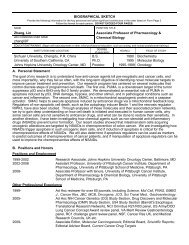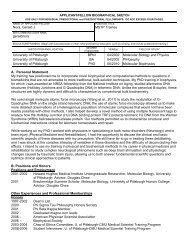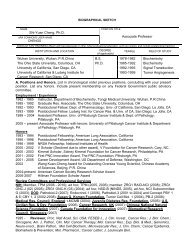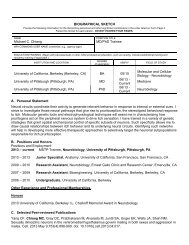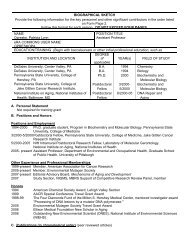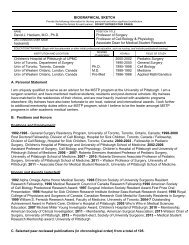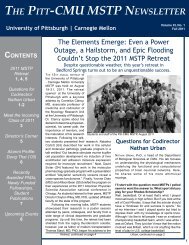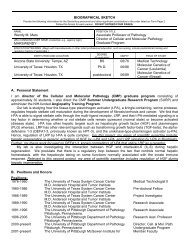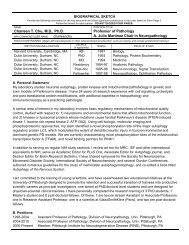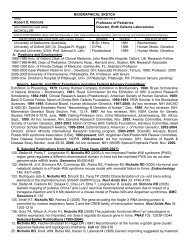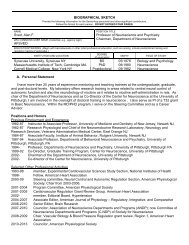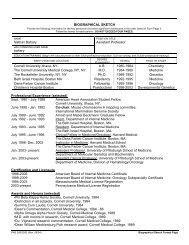The PiTT-CMU MSTP NewSleTTer - University of Pittsburgh :: MSTP
The PiTT-CMU MSTP NewSleTTer - University of Pittsburgh :: MSTP
The PiTT-CMU MSTP NewSleTTer - University of Pittsburgh :: MSTP
Create successful ePaper yourself
Turn your PDF publications into a flip-book with our unique Google optimized e-Paper software.
<strong>The</strong> <strong>PiTT</strong>-<strong>CMU</strong> <strong>MSTP</strong> <strong>NewSleTTer</strong><br />
<strong>University</strong> <strong>of</strong> <strong>Pittsburgh</strong> | Carnegie Mellon<br />
Volume IX, No. 1<br />
Fall 2010<br />
Contents<br />
2010 <strong>MSTP</strong><br />
Retreat, 1, 4<br />
Alumni Pr<strong>of</strong>ile:<br />
David Levinthal<br />
(‘06), 2-3<br />
Director’s Corner,<br />
3<br />
Grand<br />
Introductions: <strong>The</strong><br />
Incoming Class <strong>of</strong><br />
2010, 5<br />
Newly Funded<br />
Fellowships and<br />
Recently Awarded<br />
PhDs, 6<br />
2010 <strong>MSTP</strong> Annual Retreat<br />
<strong>MSTP</strong> students, faculty, alumni, and program adminstrators convened for some<br />
great science, fun and relaxation, and quality peer mentorship<br />
<strong>The</strong> 14th annual retreat <strong>of</strong> the <strong>University</strong> <strong>of</strong><br />
<strong>Pittsburgh</strong>-Carnegie Mellon <strong>University</strong> <strong>MSTP</strong><br />
was held on August 20-22, 2010. <strong>The</strong> retreat<br />
commenced on Friday, August 20th in the<br />
Biomedical Science Tower (BST) at the <strong>University</strong><br />
<strong>of</strong> <strong>Pittsburgh</strong> with an illuminating talk by the<br />
Friday keynote speaker, Laura Niedernh<strong>of</strong>er,<br />
MD, PhD, Associate Pr<strong>of</strong>essor <strong>of</strong> Microbiology<br />
and Molecular Genetics. Dr. Niederh<strong>of</strong>er spoke<br />
about her research on the process <strong>of</strong> aging, while<br />
touching upon her career path, her selection <strong>of</strong><br />
mentors, and the maturation <strong>of</strong> her scientific<br />
interests. <strong>The</strong> keynote speech was followed<br />
by two student scientific talks (meanwhile, the<br />
director <strong>of</strong> the <strong>MSTP</strong>, Clayton Wiley, MD, PhD,<br />
gave an update on the <strong>MSTP</strong> to affiliated faculty).<br />
Aaron Secrest (MS3) presented first, detailing his<br />
graduate studies in epidemiology with a talk titled<br />
“Mortality in Childhood-Onset Type I Diabetes is<br />
Improving”). Following Aaron’s talk, Sam Clanton<br />
(G6) featured his work in the <strong>CMU</strong> Robotics<br />
graduate program with a presentation titled<br />
“Simultaneous 7-Dimensional Cortical Control<br />
<strong>of</strong> an Arm and Hand Robot via Direct Brain<br />
Interface.” Next, James Bales (MS3), Yvonne<br />
Chao (G4), and Vineet Agrawal (G3) gave a<br />
presentation about their recent experience at the<br />
2010 American Physician Scientist Association<br />
national conference. Following the talks, 76<br />
students from the Pitt-<strong>CMU</strong> <strong>MSTP</strong> took over<br />
the first floor lobby <strong>of</strong> the BST to present their<br />
research in written abstract and poster formats to<br />
colleagues and faculty. After the poster session<br />
and lunch, the presentations for the William<br />
E. Brown Outstanding Mentor Award and the<br />
Drs. S. Sutton Hamilton <strong>MSTP</strong> Scholar Award<br />
were given. Satdarshan Pal Singh Monga,<br />
MD, thesis advisor to <strong>MSTP</strong> student Michael<br />
Thompson (MS3), was awarded the Outstanding<br />
Mentor Award, and Corrine Kliment (MS4)<br />
was awarded the <strong>MSTP</strong> Scholar Award for her<br />
outstanding scientific contributions in Dr. Tim<br />
Oury’s laboratory. After a group photograph was<br />
taken within the voluminous foyer <strong>of</strong> the Petersen<br />
Events Center, the retreat attendees dispersed<br />
for the drive to Seven Springs Mountain resort.<br />
<strong>The</strong> Seven Springs portion <strong>of</strong> the retreat<br />
began Friday evening with an indoor/outdoor<br />
barbeque, followed by a friendly team-building<br />
competition. Highlights <strong>of</strong> the team-building<br />
activities included trivia, a faculty-themed variant<br />
<strong>of</strong> “pin the tail on the donkey,” <strong>MSTP</strong>-themed<br />
charades, and a Rock Band finale. Later in<br />
see page 4, Retreat<br />
Student<br />
Announcements, 6<br />
Student<br />
Publications, 7<br />
Upcoming Events,<br />
8<br />
Above: <strong>The</strong> students and staff <strong>of</strong> the Pitt-<strong>CMU</strong> <strong>MSTP</strong>, August 2010. (Photo credit: <strong>University</strong> <strong>of</strong> <strong>Pittsburgh</strong><br />
CIDDE) Right top: Corrine Kliment (MS4), winner <strong>of</strong> the 2010 Drs. S. Sutton Hamilton <strong>MSTP</strong><br />
Scholar Award (Photo credit: Judd Englert, MS4) Right bottom: Michael Thompson (MS3, left) with<br />
his thesis mentor and winner <strong>of</strong> the William E. Brown Outstanding Mentor Award , Dr. Satdarshan<br />
Monga (right) after Michael’s defense. (Photo courtesy <strong>of</strong> Michael Thompson)<br />
1
Pr<strong>of</strong>iles in Medicine: David Levinthal<br />
An alumnus from the Class <strong>of</strong> 2006 explores the decisions that shaped his path from undergraduate<br />
studies at Cornell <strong>University</strong> to the Pitt-<strong>CMU</strong> <strong>MSTP</strong> and his current fellowship in GI.<br />
2<br />
Dr. David Levinthal graduated from<br />
the Pitt <strong>MSTP</strong> in 2006. Accepted into the<br />
<strong>University</strong> <strong>of</strong> Michigan’s gastroenterology<br />
fast-track program, he completed two<br />
years <strong>of</strong> Internal Medicine Residency<br />
in Ann Arbor, before returning to Pitt to<br />
pursue a post-doctoral year <strong>of</strong> research<br />
with Dr. Peter Strick in the Department <strong>of</strong><br />
Neurobiology. Dr. Levinthal continued to<br />
do full-time research with Dr. Strick during<br />
the first year <strong>of</strong> his GI Fellowship and is<br />
now entering his second fellowship year.<br />
Below, he shares his candid thoughts<br />
on his career path and advice for future<br />
physician-scientists.<br />
Q: How did you decide on a career as<br />
an MD-PhD?<br />
A: I have known from an early age that I<br />
wanted to pursue a career in the sciences.<br />
That interest became more specifically<br />
targeted to neuroscience by the time I<br />
completed college and began medical<br />
school. I had a tremendous research<br />
experience in my undergraduate lab at<br />
Cornell <strong>University</strong>, working on vitamin A<br />
metabolism, intracellular trafficking, and<br />
nuclear receptor interaction. Although this<br />
experience prepared me well for the reality<br />
and frustrations <strong>of</strong> laboratory science, I<br />
loved it and was hooked. In retrospect,<br />
I realize that my mentor gave me a lot <strong>of</strong><br />
responsibility and an actual, publishable<br />
project – my data ended up in a JBC<br />
publication! I had a solid two years with<br />
that group, and I felt a bit like a graduate<br />
student by the end. After that experience,<br />
there was no question in my mind that I<br />
wanted to be a scientist.<br />
Cornell has a very strong premed<br />
curriculum and I had a few good<br />
experiences shadowing physicians, as<br />
well as doing a hospital-based research<br />
project, but I wasn’t sure I wanted to<br />
pursue medicine at first. I thought I had to<br />
make a choice, and although I really liked<br />
the idea <strong>of</strong> being a physician, I would have<br />
pursued a PhD program if I’d been forced<br />
to decide between the two.<br />
<strong>The</strong>n I learned about MD/PhD<br />
programs. What a perfect fit! You can do<br />
BOTH? What a cool way to synthesize<br />
patient care, basic science, and the<br />
potential for translational research. When<br />
the time came to apply to medical school,<br />
I applied to mostly MD/PhD programs.<br />
Q: How did you pick your thesis lab<br />
and mentor?<br />
A: I think the main drives for choosing<br />
my thesis lab were: 1) to actually like my<br />
mentor as a person (and potential friend)<br />
2) finding a mentor with a good reputation<br />
as a advisor/teacher, and 3) being<br />
presented with a clear idea about my<br />
research project from the very beginning.<br />
I interviewed with many advisors, but<br />
ultimately when I met Don DeFranco we<br />
just clicked. He had a great idea for a<br />
research project dealing with oxidative<br />
stress and cell death in neurons, and so I<br />
signed on. I think it’s really important that a<br />
thesis project have discernable research<br />
goals and publishable experimental units<br />
that are designed to answer a question no<br />
matter what the result. Dr. DeFranco had<br />
a clear sense <strong>of</strong> my thesis project pretty<br />
much from the start, and he laid it all out<br />
when we first met. I decided to join the lab<br />
because the project appeared interesting<br />
and feasible. We applied for an F-30 and<br />
it was funded in the first round <strong>of</strong> review,<br />
largely because he had already put a lot<br />
<strong>of</strong> thought into the project before we even<br />
got started. That helped me get through<br />
my PhD in a timely manner (3.5 years)<br />
even with the anticipated research snags<br />
and inevitable technical problems.<br />
Q: How did you choose your specialty?<br />
A: Like most medical students, I didn’t<br />
know which direction I was going in<br />
until sometime during third year. By the<br />
time I’d nearly finished graduate school,<br />
I had developed an interest in pain<br />
research, so I thought about how best to<br />
pursue that – anesthesiology? neurology?<br />
internal medicine? After I started third<br />
year rotations, it became clear to me that<br />
internal medicine really was the best fit.<br />
<strong>The</strong>n I had to come up with a specialty.<br />
So I did rotations in gastroenterology,<br />
endocrine, and critical care. After reflecting<br />
and speaking with faculty, I realized that<br />
my interests were directed toward a<br />
procedure-based specialty that required<br />
a broad scope <strong>of</strong> medical knowledge. For<br />
me, that specialty was gastroenterology.<br />
GI deals with multiple organs, complex<br />
physiology, manifestations <strong>of</strong> disease<br />
secondary to systemic illness, among other<br />
things – in total, a complex and varied field.<br />
Perfect for me. <strong>The</strong>n how does GI relate to<br />
neuroscience? Well one <strong>of</strong> the fascinating<br />
aspects <strong>of</strong> GI is the mind-body connection<br />
that likely plays a role in functional bowel<br />
disorders. While intuitively connected, the<br />
neurophysiologic basis <strong>of</strong> CNS control<br />
over GI function is poorly understood.<br />
As you may imagine, there are not many<br />
neuro-gastroenterologists, so my interest<br />
in neuroscience seemed like a natural fit<br />
to fill this gap in knowledge. In addition,<br />
from a funding standpoint, it’s always a<br />
good thing to study an incredibly prevalent<br />
disease, and to be uniquely trained to do<br />
so.<br />
Q: Can you tell me what a typical day<br />
for you right now is like?<br />
A: Right now, my days are spent on<br />
inpatient consults, performing procedures,<br />
and spending half a day a week in<br />
continuity clinic. I’m on-call once every<br />
eight to nine days, and during that time,<br />
I cover the VA, Magee, and Montefiore/<br />
Presby. It can get very busy. Our fellowship<br />
program has an impressive educational<br />
component with lectures/conferences<br />
throughout the week, typically starting<br />
at 7:30 a.m. So a typical day could be:<br />
conference from 7:30-8:30 a.m., see<br />
follow-up patients in the hospital, get new<br />
consults, do some procedures, finish<br />
see page 3, Levinthal
On June 1, 2010 we matriculated<br />
a new class <strong>of</strong> 14 students (13 new<br />
students in addition to one internal<br />
second year medical student). As in<br />
past years, the new students hail from<br />
outstanding undergraduate schools<br />
where they excelled in both academics<br />
and research. With an average GPA <strong>of</strong><br />
3.73 and an average MCAT <strong>of</strong> ~35 they<br />
demonstrate the continued success <strong>of</strong><br />
our <strong>MSTP</strong> to matriculate the best and the<br />
brightest. All <strong>of</strong> the first years completed<br />
their first pr<strong>of</strong>essional development<br />
course (molecular medicine) in addition<br />
to a lab rotation from which they compiled<br />
their Retreat posters.<br />
For the rising second year<br />
students, this was the inaugural year <strong>of</strong><br />
the summer pr<strong>of</strong>essional development ii<br />
course (methods and analysis) taught by<br />
Dr. Ge<strong>of</strong>f Murdoch and myself. In addition<br />
to learning about their classmates’<br />
summer research, the students were<br />
given ample opportunity to formally<br />
present their data and begin to create<br />
their “elevator spiel” for use in future<br />
networking. To keep them “<strong>of</strong>f their toes,”<br />
the students sampled a variety <strong>of</strong> red<br />
wines throughout the course and then<br />
were rigorously grilled in a blind tasting.<br />
Only one student correctly matched all<br />
the wines to grapes, so while Neil Kelly<br />
has a potential additional career as a<br />
sommelier, the rest will have<br />
to buckle down to science<br />
and medicine.<br />
This fall begins our<br />
<strong>MSTP</strong> workshops, a yearlong<br />
series <strong>of</strong> eight discussions<br />
over dinner. <strong>The</strong>se workshops<br />
are designed to maximize interactions<br />
between students across different<br />
stages <strong>of</strong> training. Groups <strong>of</strong> eight<br />
students (one student from each class)<br />
will analyze research, training, medical<br />
and ethical cases germane to the<br />
training <strong>of</strong> all physician scientists. Each<br />
class, in turn, will have the opportunity<br />
to contribute to the case discussed,<br />
Director’s Corner<br />
A Message From Clayton Wiley, MD, PhD<br />
Associate Dean, Director <strong>of</strong> <strong>MSTP</strong><br />
lead the discussion at their respective<br />
tables, and to summarize the outcome<br />
<strong>of</strong> the dinner discussion and potentially<br />
present it in a written form such as in<br />
future newsletters. Like all other aspects<br />
<strong>of</strong> our <strong>MSTP</strong>, the workshops are an<br />
experiment and represent our continued<br />
efforts to push the edge <strong>of</strong> the envelope<br />
in training physician scientists.<br />
from page 2, Levinthal<br />
documentation, go home by about 6:30-7<br />
p.m. Repeat.<br />
But the past two years I was doing<br />
100 percent research during a post-doc<br />
period <strong>of</strong> training built into my fast-track<br />
pathway in GI. <strong>The</strong> fast-track is a relatively<br />
new training path in internal medicine<br />
designed for MD/PhDs who have a very<br />
good sense <strong>of</strong> what specialty they wish to<br />
pursue. For GI, the pathway is two years<br />
residency plus four years fellowship (two<br />
and a half years <strong>of</strong> which can be spent<br />
doing research).<br />
Q: How do you balance family time<br />
and career or how do you see yourself<br />
balancing these in the future?<br />
A: My wife, Sarah, and I have found a<br />
balance that works for us. It was really<br />
hard to have quality time with her during<br />
my internship – I was a walking zombie for<br />
most <strong>of</strong> the year. But she was so wonderful<br />
and supportive – I don’t think I could have<br />
made it through it without her. <strong>The</strong> best<br />
advice is to really make the most <strong>of</strong> the time<br />
you have with your family. We tend to plan<br />
little day trips or outings for my days <strong>of</strong>f.<br />
That makes them memorable and special.<br />
Our son was born last August<br />
and I was very fortunate to have a flexible<br />
schedule last year. Now it’s much harder<br />
that I’m back in the clinic full-time. Again,<br />
the days <strong>of</strong>f are precious and my first<br />
priority is to spend time with the family.<br />
<strong>The</strong>re is no question that pursuing a<br />
medical career puts a strain on family life.<br />
But the silver lining is that an academic<br />
medicine career, once well established,<br />
may present some opportunities for a<br />
more flexible schedule. Someday. Maybe.<br />
Q: Where do you see yourself in ten<br />
years?<br />
A: By then I will certainly be on the faculty<br />
somewhere, likely here at the <strong>University</strong><br />
<strong>of</strong> <strong>Pittsburgh</strong> if all works out. I hope to<br />
have my second R01 grant by then and<br />
have made it to the rank <strong>of</strong> associate<br />
pr<strong>of</strong>essor with a successful tenure. My<br />
ideal balance would be to have about 80<br />
percent <strong>of</strong> my time devoted to research<br />
with 20 percent clinical effort. I’d also like<br />
to be involved in national GI organizations<br />
like the AGA by serving on committees,<br />
as well as beginning to be invited to give<br />
presentations at outside institutions. I’d<br />
also like to have an independent lab, with<br />
graduate students, post-docs, and possibly<br />
fellows working with me. <strong>The</strong> coolest thing<br />
would be to begin to translate some <strong>of</strong> my<br />
research into actual therapeutic trials. A tall<br />
order, but one can dream.<br />
Q: What advice do you have for current<br />
<strong>MSTP</strong> students?<br />
A: ASK QUESTIONS! Navigating this<br />
career path is very difficult. It is easy to<br />
lose time. Before making any <strong>of</strong> the major<br />
decisions, ask lots and lots <strong>of</strong> questions<br />
– <strong>of</strong> the alumni, <strong>of</strong> students further<br />
along in the program, <strong>of</strong> PhD program<br />
students, post-docs, everyone. Don’t<br />
forget about your original class <strong>of</strong> medical<br />
students that went straight through to<br />
residency. <strong>The</strong>y are seasoned, veteran<br />
residents/fellows, maybe even attending<br />
physicians, by the time you are applying<br />
to residency programs. <strong>The</strong>ir input is<br />
invaluable because they are your friends<br />
and they’ll give you the honest truth about<br />
specific residencies and career paths.<br />
Q: Final thoughts?<br />
A: I couldn’t have made a better decision<br />
for my career. Every year that goes by, I<br />
love practicing medicine more and more.<br />
It becomes a part <strong>of</strong> your self-image and<br />
at this point, after being involved in patient<br />
care to some degree since 1998, it’s pretty<br />
hard-wired into me. Of course, research<br />
has always been something that I have<br />
loved from the start.<br />
Interview conducted by Niyathi Hegde<br />
(G1)<br />
Alunni Relations Chair<br />
Dr. David Levinthal can be reached at<br />
dlevinth@pitt.edu<br />
3
from page 1, Retreat<br />
the evening, there was free time and<br />
students enjoyed a poker tournament,<br />
various jam sessions, and the Rock Band<br />
video game. At the end <strong>of</strong> the evening,<br />
David Wheeler (G3)led the incoming<br />
<strong>MSTP</strong> students on the traditional hike to<br />
the top <strong>of</strong> the Seven Springs mountain.<br />
Saturday morning started<br />
<strong>of</strong>f with the classic Seven Springs<br />
hearty breakfast buffet followed by<br />
the “State <strong>of</strong> the Program” address<br />
given by Dr. Clayton Wiley. Dr. Wiley<br />
introduced the newest members <strong>of</strong><br />
the <strong>MSTP</strong> before discussing issues<br />
ranging from medical school reentry to<br />
USMLE Step 1 board exam changes.<br />
Following Dr. Wiley’s address,<br />
graduating MS4 students imparted<br />
pearls <strong>of</strong> wisdom garnered through<br />
their years <strong>of</strong> training in PowerPoint<br />
form. This year junior students listened<br />
to insightful presentations by Mandar<br />
Aras, Mehret Birru, Frank Cackowski,<br />
Judd Englert, Melanie Ruffner, Corrine<br />
Kliment, Jeremy Tilstra, Pete Vosler, and<br />
Genevieve Woodard. Retreat attendees<br />
were also honored to hear a presentation<br />
on alternative career options for <strong>MSTP</strong><br />
graduates by Pedram Afshar, MD, PhD,<br />
who graduated from the Pitt-<strong>CMU</strong> <strong>MSTP</strong><br />
in 2009.<br />
This year, four workshops were<br />
prepared for the Saturday afternoon<br />
session instead <strong>of</strong> the traditional three<br />
to address the interests <strong>of</strong> students at<br />
all different levels <strong>of</strong> training. For the<br />
incoming first years, <strong>MSTP</strong> co-directors<br />
Richard Steinman, MD, PhD, and<br />
George Stetten, MD, PhD, introduced<br />
the scientific community in <strong>Pittsburgh</strong><br />
and discussed using scientific resources<br />
here to advance a translational research<br />
agenda. Second year students were<br />
treated to a presentation covering study<br />
tips for their upcoming USMLE Step<br />
1 board exam later in the school year.<br />
For junior graduate students, Michelle<br />
Kienholz, a pr<strong>of</strong>essional science writereditor<br />
at the <strong>University</strong> <strong>of</strong> <strong>Pittsburgh</strong>,<br />
spoke about communication in science<br />
through manuscripts, oral presentations,<br />
and other avenues. For senior graduate<br />
students, Dr. Wiley and alumnus Brian<br />
Shirts, MD, PhD (Class <strong>of</strong> 2006) gave<br />
a presentation about interviewing for<br />
residency, a departure from previous<br />
years in which the topic was negotiating<br />
your first job after residency. Following<br />
the workshops, students were able to<br />
relax and enjoy the resort’s various<br />
outdoor recreational activities, including<br />
volleyball, swimming, tennis, and bicycling<br />
(organized by Mike Leibowitz, G5).<br />
Evening brought along a candlelit<br />
dinner featuring the entrees New<br />
York Strip Steak, Broiled Crabcakes,<br />
and Eggplant Tower. <strong>The</strong> Saturday<br />
night keynote speaker was alumnus<br />
Robert Labadie, MD, PhD (Class<br />
<strong>of</strong> 1996), Associate Pr<strong>of</strong>essor <strong>of</strong><br />
Otolaryngology-Head and Neck Surgery<br />
& Bioengineering from Vanderbilt<br />
<strong>University</strong>. He spoke about his career<br />
trajectory and research while pausing<br />
to <strong>of</strong>fer various “pearls” <strong>of</strong> wisdom<br />
along the way regarding successfully<br />
navigating a career as a physician<br />
scientist. Following the completion <strong>of</strong><br />
<strong>of</strong>ficial activities, students enjoyed an<br />
evening <strong>of</strong> social activities, including<br />
another jam session. On Sunday, many<br />
students opted to participate in the<br />
<strong>MSTP</strong>-sponsored golf and whitewater<br />
rafting outings (organized by Gaurav<br />
Shukla (G5) and Dani Simmonds (G1),<br />
respectively).<br />
by John Kang (G2)<br />
2010 Retreat Co-chair<br />
4<br />
Above Top Left: Dr. Laura Niedernh<strong>of</strong>er talks about her career path and current research program at the Keynote Address. (Photo credit: David Svilar, G3) Above Top Middle:<br />
Jeff Koenitzer (G3), Maxx Horowitz (G4) and Daniel Roh (G4) raise the ro<strong>of</strong> with their jazzy tune. (Photo credit: Liang-I Kang, G3) Above Top Right: <strong>MSTP</strong> students present their<br />
latest data to their peers and to faculty at the poster sessions on Friday. (Photo credit: David Svilar) Above left: During the Friday night team-building activities, a blindfoleded<br />
Dr. Clayton Wiley cautiously attempts to “pin the glasses on the Murdoch” using only his teammates’ shouted insrtuctions to guide him. (Photo credit: Liang-I Kang) Above Right:<br />
MS1s and accompanying upperclassmen stand triumphantly on the peak <strong>of</strong> the ski slope after the notoriously symbolic hike. (Photo credit: Liang-I Kang)
Grand Introductions: the incoming<br />
Class <strong>of</strong> 2010<br />
THE BAD (as in good) BOYS<br />
Up first…Matthew Hedberg: Matt hails from the <strong>University</strong> <strong>of</strong><br />
Utah. He is interested in the BMG graduate program. Mr. Hedberg<br />
enjoys going out (agoraphobics have less fun), watching movies,<br />
and going to concerts. In a single word, his entire essence can be<br />
summed up as cogent. I suppose he convinced the right people to<br />
let him join our ranks.<br />
Runner up…Benjamin Rothrauff: Ben attended Northwestern<br />
<strong>University</strong>. He plans to join the bioengineering program. In his<br />
free time Ben likes exercising, learning biomechanics, and reading.<br />
Fortunately he can exercise his brain while reading about biomechanics<br />
to maximize his time. Mr. Rothrauff can be described<br />
as simply urbane, bringing class and sophistication to the city <strong>of</strong><br />
<strong>Pittsburgh</strong>.<br />
Third, but not third-rate…Brian Ahn: Brian joins us from<br />
the <strong>University</strong> <strong>of</strong> California, Berkeley. Just like our other Brian<br />
(Rosborough), he will be joining the immunology graduate program.<br />
For fun, Mr. Ahn enjoys outdoor activities like rock climbing<br />
and hiking as well as playing guitar and anything physical. Guys<br />
that are musically, mentally, and physically gifted can only be described<br />
as versatile.<br />
Connect Four…Xuan Ding: Mr. Ding will ring your bell. Joining us<br />
from Duke <strong>University</strong>, he plans to study bioengineering/biomedical<br />
engineering. In his spare time, he plays basketball, watches<br />
TV, and participates in outdoor activities. Like most scientists, he<br />
considers himself to be a pragmatist.<br />
Favorite (#) Five…Bo Wang: Bo is anything but Bo-ring. He likes<br />
to split his time among school, soccer, Starcraft II, and badminton.<br />
Mr. Wang is going into the bioengineering program. He went to<br />
the <strong>University</strong> <strong>of</strong> <strong>Pittsburgh</strong> for his undergraduate degree and is<br />
staying with us. Bo describes himself as a meanderer, but faithful<br />
seems more fitting.<br />
Sizzling Six…Daniel Chung: Dan went to Johns Hopkins <strong>University</strong><br />
for undergrad and is looking forward to joining CNUP for<br />
graduate education. Like his fellow first-year Bo, he enjoys Starcraft<br />
in addition to most video games and watching movies. Don’t<br />
be fooled--Daniel is no couch potato, but describes himself plainly<br />
as moderate.<br />
<strong>The</strong> Flavorful First Year…Matthew Geramita: Coming from the<br />
<strong>University</strong> <strong>of</strong> Michigan, Matt is planning on joining the neuroscience<br />
graduate program. Mr. Geramita enjoys running, grilling, and<br />
exploring used book stores. As a grill king, Matt’s fundamental nature<br />
can only be described as hickory-smoked.<br />
Knock. Knock. Who’s there?…Jared Moreines: Joining us from<br />
the South, Jared attended Emory <strong>University</strong>. This Southern gentleman<br />
is planning to join the neuroscience graduate program. Mr.<br />
Moreines enjoys cooking, skiing, and tennis. In addition to his skills<br />
inside and outside <strong>of</strong> the kitchen, Jared is humorous. Who knew<br />
we had a jokester on our hands?<br />
Last but not least…James (Randall) McAuley: Randall, like his<br />
fellow first-year Bo, just can’t get enough <strong>of</strong> Pennsylvania. He attended<br />
Swarthmore College and is keeping an open mind about<br />
graduate programs at Pitt. Mr. McCauley likes to fence, hike, and<br />
play the cello. With his courtly ways, he’ll be playing our heart<br />
strings in no time.<br />
THE PHENOMENAL FEMALES<br />
Numero Uno…Adrienne Taren: Adrienne graduated from<br />
Middlebury College in 2009. She plans to study neuroscience/psychology<br />
at <strong>CMU</strong> during her graduate school years.<br />
She enjoys biking, running, and dancing. As a true physical<br />
activity enthusiast, she can be described as enigmatic.<br />
Dueces wild…Beth Oczypok: Beth is joining the ranks <strong>of</strong><br />
our fellow “<strong>Pittsburgh</strong> lifers,” hailing from the <strong>University</strong> <strong>of</strong><br />
<strong>Pittsburgh</strong>. She’s looking forward to joining the BMG program.<br />
Beth enjoys reading, baking, and traveling. Perhaps<br />
her nurturing persona will score us some baked goods at the<br />
monthly <strong>MSTP</strong> workshops.<br />
Triple threat…Julie Boiko: Julie excels on land, water, and<br />
air! Joining us from Stanford <strong>University</strong>, Julie has landed herself<br />
in the first year <strong>MSTP</strong> class. She enjoys swimming and<br />
traveling, and describes herself as aquatic. However, she<br />
plans to join the immunology program (a rather dry field).<br />
Julie also enjoys reading about theology in her spare time.<br />
Fantastic Four…Rachael Gordon: Rachael attended the<br />
<strong>University</strong> <strong>of</strong> Pennsylvania for undergraduate education.<br />
She plans to join the immunology graduate program here<br />
at Pitt. Beware! Miss Gordon practices martial arts, so you<br />
don’t want to come across her path in a dark alley. She also<br />
enjoys cooking and home-brewing. Just like a bittersweet<br />
beer, Rachael can be described as hoppy.<br />
(Note: Rank according to order <strong>of</strong> email response.)<br />
by Natasha Corbitt (G2)<br />
2010-2011 Peer Mentorship/Welcoming Chair<br />
Above: (back row, left to right) Matthew Geramita, Jared<br />
Moreines, Matthew Hedberg, Benjamin Rothrauff, (front row, left<br />
to right) Brian Ahn, Xuan Ding, J. Randall McAuley, Julie Boiko,<br />
Elizabeth Oczypok, Adrienne Taren, Bo Wang, D. Wonjae Chung,<br />
Rachael Gordon (Photo credit: <strong>University</strong> <strong>of</strong> <strong>Pittsburgh</strong> CIDDE)<br />
5
Student Accolades<br />
Congratulations to our newly funded Fellowships!<br />
Vineet Agrawal<br />
ECM Degradation and Macrophage Polarization in<br />
Endogenous Stem Cell Recruitment (F30, Mentor:<br />
Stephen Badylak, MD, PhD)<br />
Natasha Corbitt<br />
<strong>The</strong> Role <strong>of</strong> Gut Bacteria in Kupffer Cell Developmental<br />
and Function (F31, Mentor: A. Jake Demetris,<br />
MD)<br />
Gil H<strong>of</strong>tman<br />
Developmental Trajectories <strong>of</strong> Prefrontal Cortical<br />
GABA Neurons and Schizophrenia (F30, Mentor:<br />
David Lewis, MD)<br />
Max Horowitz<br />
GATA2 as a <strong>The</strong>rapeutic Target in Parkinson’s Disease<br />
(F30, Mentor: J. Timothy Greenamyre, MD,<br />
PhD)<br />
Benjamin Mantell<br />
Metabolic Crosstalk Between Cells and the Liver in<br />
Obesity (F30, Mentor: Robert O’Doherty, PhD)<br />
Jason Sanders<br />
Epidemiology <strong>of</strong> Lens Aging in Older Women (F30,<br />
Mentor: Anne Newman, MD, MPH)<br />
Congratulations, Doctor! Recently Awarded PhDs<br />
James Bales<br />
Dopamine and Camp Regulated Phosphoprotein, 32 KDA: A novel therapeutic target in traumatic brain injury,<br />
Advisor: Edward Dixon, PhD (Neuroscience, Pitt)<br />
Christin Glorioso<br />
Between Destiny and Disease: Genetics and Molecular Pathways <strong>of</strong> Human Central Nervous System Aging,<br />
Advisor: Etienne Sibille, PhD (Neuroscience, Pitt)<br />
Carl Johnson<br />
Preclinical Biocompatibility Assessment <strong>of</strong> Pediatric Ventricular Assist Devices, Advisor: William Wagner, PhD<br />
(Bioengineering, Pitt)<br />
Gerald Nora<br />
Processing <strong>of</strong> Alternative DNA Structures in the Human Telomere, Advisor: Patricia Opresko, PhD (Molecular<br />
Biophysics/Structural Biology, Pitt)<br />
Aaron Secrest<br />
Mortality Trends in a Population-based Type 1 Diabetes Cohort, Advisor: Trevor Orchard, MBBCh, MMedSci<br />
(Epidemiology, Pitt)<br />
Michael Thompson<br />
β-cantenin: A friend or foe in liver pathobiology, Advisor: Satdarshan Monga, MD (Cellular & Molecular<br />
Pathology, Pitt)<br />
Student Announcements<br />
6<br />
David Wheeler (G3) and Amir Faraji (G4) attended the 2010<br />
Nobel Laureate Meeting at Lindau (Germany) from June 27-<br />
July 2, 2010. Amir was sponsored by the NIH and David was<br />
sponsored by the Oak Ridge Associated Universities (ORAU).<br />
Lola Grace Grimm Secrest (6 lb<br />
11 oz, 19.5 inches) was born to<br />
Aaron (MS3) and Katie Secrest<br />
on June 26, 2010.
New <strong>MSTP</strong> Student Publications through September 2010<br />
Kaczorowski, D.J., Afrazi, A., Scott, M.J., Kwak, J.H., Gill, R., Edmonds, R.D., Liu, Y.,<br />
Fan, J., and T.R. Billiar. (2010). Pivotal Advance: <strong>The</strong> pattern recognition receptor<br />
ligands lipopolysaccharide and polyinosine-polycytidylic acid stimulate factor<br />
B synthesis by the macrophage through distinct but overlapping mechanisms. J<br />
Leukoc Biol.Oct; 88(4):609-18. [PMID: 20413727]<br />
Richardson, W.M., Sodhi, C.P., Russo, A., Siggers, R.H., Afrazi, A., Gribar, S.C.,<br />
Neal, M.D., Dai, S., Prindle, T. Jr, Branca, M., Ma, C., Ozolek, J., Hackam DJ.<br />
(2010). Nucleotide-binding oligomerization domain-2 inhibits toll-like receptor-4<br />
signaling in the intestinal epithelium. Gastroenterology. Sep; 139(3):904-17, 917.<br />
e1-6. [PMID: 20580721]<br />
Bales, J.W., Ma, X., Yan, H.Q., Jenkins, L.W., and C.E. Dixon. (2010). Alterations in<br />
calcineurin subunit B is<strong>of</strong>orm expression in rat hippocampus following a traumatic<br />
brain injury. Brain Res. Oct 28; 1358:211-20. [PMID: 20713027]<br />
Bridges, J.P., Ikegami, M., Brilli, L.L., Chen, X., Mason, R.J., and J.M. Shannon.<br />
(2010). LPCAT1 regulates surfactant phospholipid synthesis and is required<br />
for transitioning to air breathing in mice. J. Clin. Invest. May 3; 120(5):1736-48.<br />
[PMID: 20407208]<br />
Chan, V., Starr, P.A., and R.S. Turner. (2010). Bursts and oscillations as independent<br />
properties <strong>of</strong> neural activity in the parkinsonian globus pallidus internus. Neurobiol.<br />
Dis. Aug 18 [Epub ahead <strong>of</strong> print; PMID: 20727974]<br />
Chao, Y.*, Shepard, C.R.*, and A. Wells. (2010). Breast carcinoma cells re-express<br />
E-cadherin during mesenchymal to epithelial reverting transition. Mol Cancer. Jul<br />
7; 9(1):179. [PMID: 20609236]<br />
Rajagopalan, M.S., Stone, B., Rwigema, J.C., Salimi, U., Epperly M.W., G<strong>of</strong>f, J.,<br />
Franicola, D., Dixon, T., Cao, S., Zhang, X., Buchholz, B.M., Bauer, A.J., Choi,<br />
S., Bakkenist, C., Wang, H., and J.S. Greenberger. (2010). Intraesophageal<br />
Manganese Superoxide Dismutase-Plasmid Liposomes Ameliorates Novel Total-<br />
Body and Thoracic Radiation Sensitivity <strong>of</strong> NOS1(-/-) Mice. Radiat Res. Sep;<br />
174(3):297-312. [PMID: 20726721]<br />
White, J.S., Choi, S., and C.J. Bakkenist. (2010). Transient ATM kinase inhibition<br />
disrupts DNA damage induced sister chromatid exchange. Sci Signal. Jun 1;<br />
3(124):ra44. [PMID: 20516478]<br />
Choi, S., Gamper, A.M., White, J.S., and C.J. Bakkenist. (2010). Inhibition <strong>of</strong> ATM<br />
kinase activity does not phenocopy ATM protein disruption: implications for the<br />
clinical utility <strong>of</strong> ATM kinase inhibitors. Cell Cycle. Oct 15; 9(20):4052-7. [PMID:<br />
20953138]<br />
Frank, G.M.*, Divito, S.J.*, Maker, D.M., Xu, M., and R.L. Hendricks. (2010). A novel<br />
p40-independent function <strong>of</strong> IL-12p35 is required for progression and maintenance<br />
<strong>of</strong> herpes stromal keratitis. Invest Ophthalmol Vis Sci. Jul;51(7):3591-8. [PMID:<br />
20207959] *Co-first authors<br />
Divito, S.J., Wang, Z., Shufesky, W.J., Liu, Q, Tkacheva, O.A., Montecalvo, A., Erdos,<br />
G., Larregina, A.T., and A.E.Morelli. (2010). Endogenous dendritic cells mediate<br />
the effects <strong>of</strong> intravenously injected therapeutic immunosuppressive dendritic cells<br />
in transplantation. Blood. Oct 14;116(15):2694-705. [PMID: 20576812]<br />
Divito, S.J. and L.K. Ferris. (2010). Advances and short-comings in the early detection<br />
<strong>of</strong> melanoma. Melanoma Res. Dec; 20(6):450-8. [PMID: 20856147]<br />
Marenco, S., Savostyanova, A., van der Veen, J.W., Geramita, M., Stern, A., Barnett,<br />
A.S., Kolachana, B., Radulescu, E., Zhang, F., Callicott, J.H., Straub, R.E., Shen,<br />
J. and D.R. Weinberger. (2010). Genetic modulation <strong>of</strong> GABA levels in the anterior<br />
cingulate cortex by GAD1 and COMT. Neuropsychopharmacology. Jul;35(8):1708-<br />
17. [PMID: 20357758]<br />
Glorioso, C., Oh, S., Duillard, G. and E. Sibille. (2010). Brain molecular aging, promotion<br />
<strong>of</strong> neurological disease and modulation by Sirtuin5 longevity gene polymorphism.<br />
Neurobiol Dis. Sep 29. [Epub ahead <strong>of</strong> print; PMID: 20887790]<br />
Wang, L, Gordon, R.A., Huynh, L., Su, X., Park Min, K.H., Han, J., Arthur, J.S., Kalliolias,<br />
G.D., and L.B. Ivashkiv. (2010). Indirect inhibition <strong>of</strong> Toll-like receptor and<br />
type I interferon responses by ITAM-coupled receptors and integrins. Immunity.<br />
Apr 23; 32(4):518-30. [PMID: 20362473]<br />
Gupta, A.S., van der Meer, M.A.A., Touretzky, D.S., and A.D. Redish. (2010). Hippocampal<br />
replay is not a simple function <strong>of</strong> experience. Neuron. Mar 11; 65(5):695-<br />
705. [PMID: 20223204]<br />
Haldar, M., Hedberg, M.L., Hockin, M.F., and M.R. Capecchi. (2009). A CreER based<br />
random induction strategy for modeling translocation-associated sarcomas in mice.<br />
Cancer Res. Apr 15; 69 (8):3657-64. [PMID: 19351831]<br />
Marcu, J.P., Christian, R.T., Lau, D., Zielinski, A.J., Horowitz, M.P., Lee, J., Pakdel, A.,<br />
Allison, J., Limbad, C., Moore, D.H., Yount, G.L., Desprez, P.Y., and S.D. McAllister.<br />
(2010). Cannabidiol enhances the inhibitory effects <strong>of</strong> Δ9-tetrahydrocannabinol<br />
on human glioblastoma cell proliferation and survival. Mol Cancer <strong>The</strong>r. Jan;<br />
9(1):180-9. [PMID: 20053780]<br />
Horowitz, M.P. and J.T. Greenamyre. (2010). Mitochondrial iron metabolism and<br />
its role in neurodegeneration. J Alzheimer’s Dis. 20 Suppl. 2: S551-68. [PMID:<br />
20463401]<br />
Horowitz, M.P. and J.T. Greenamyre. (2010). Gene-environment interactions in Parkinson’s<br />
disease: <strong>The</strong> importance <strong>of</strong> animal modeling. Clin Pharmacol and <strong>The</strong>r.<br />
Oct; 88(4):467-74. [PMID: 20811350]<br />
Bosch, J.J., Iheagwara, U.K., Reid, S., Srivastava, M.K., Wolf, J., Lotem, M., Ksander,<br />
B.R., and S. Ostrand-Rosenberg. (2010). Uveal melanoma cell-based vaccines<br />
express MHC II molecules that traffic via the endocytic and secretory pathways<br />
and activate CD8(+) cytotoxic, tumor-specific T cells. Cancer Immunol Immunother.<br />
Jan; 59(1):103-12. [PMID: 19557412]<br />
Johnson, C.A. Jr., Vandenberghe, S., Daly, A.R., Woolley, J.R., Snyder, S.T., Verkaik,<br />
J.E., Ye, S.H., Borovetz, H.S., Antaki, J.F., Wearden, P.D., Kameneva, M.V., and<br />
W.R. Wagner. (2010). Biocompatibility assessment <strong>of</strong> the first generation Pedia-<br />
FlowTM Pediatric Ventricular Assist Device. Artif Organs. Jul 9 [Epub ahead <strong>of</strong><br />
print; PMID: 20626737]<br />
Ye, S.Ho., Johnson, C.A. Jr., Woolley, J.R., Murata, H., Gamble, L.J., Ihsihara, K., and<br />
W.R. Wagner. (2010). Simple surface modification <strong>of</strong> a titanium alloy with silanated<br />
zwitterionic phosphorylcholine or sulfobetaine modifiers to reduce thrombogenicity.<br />
Colloids Surf B Biointerfaces. Sep 1; 79(2):357-64. [PMID: 20547042]<br />
Zhong, Z., Chang, S.A., Kalinowski, A., Wilson, K.L., and K.N. Dahl. (2010). Stabilization<br />
<strong>of</strong> the spectrin-like domains <strong>of</strong> nesprin-1alpha by the evolutionarily conserved<br />
“adaptive” domain. Cell Mol Bioeng. Jun 1; 3(2):139-150. [PMID: 20563238]<br />
Dahl, K.N., Kalinowski, A., and K. Pekkan. (2010). Mechanobiology and the microcirculation:<br />
cellular, nuclear and fluid dynamics. Microcirculation. Apr; 17(3):179-91.<br />
[PMID: 20374482]<br />
Kliment, C.R., and T.D. Oury. (2010). Oxidative stress, extracellular matrix targets,<br />
and idiopathic pulmonary fibrosis. Free Radic Biol Med. Sep 1; 49(5):707-17.<br />
[PMID: 20452419]<br />
Houghton, A.M., Rzymkiewicz, D.M., Ji, H., Gregory, A.D., Egea, E.E., Metz, H.E.,<br />
Stolz, D.B., Land, S.R., Marconcini, L.A., Kliment, C.R., Jenkins, K.M., Beaulieu,<br />
K.A., Mouded, M., Frank, S.J., Wong, K.K., and S.D. Shapiro. (2010). Neutrophil<br />
elastase mediated degradation <strong>of</strong> IRS-1 accelerates lung tumor growth. Nat Med.<br />
Feb; 16(2):219-23. [PMID: 20081861]<br />
Koenitzer, J.R., and B.A. Freeman. (2010). Redox signaling in inflammation: interactions<br />
<strong>of</strong> endogenous electrophiles and mitochondria in cardiovascular disease. Ann<br />
NY Acad Sci. Aug; 1203:45-52. [PMID: 20716282]<br />
Polk, A.A., Maul, T.M., McKeel, D.T., Snyder, T.A., Lehocky, C.A., Pitt, B., Stolz, D.B.,<br />
Federspiel, W.J., and W.R. Wagner. (2010). A biohybrid artificial lung prototype<br />
with active mixing <strong>of</strong> endothelialized microporous hollow fibers. Biotechnol Bioeng.<br />
Jun 15; 106(3):490-500. [PMID: 20091735]<br />
Tottey, S., Corselli, M., Jeffries, E.M., Londono, R., Peault, B., and S.F. Badylak. (2010).<br />
Extracellular matrix degradation products and low oxygen conditions enhance the<br />
regenerative potential <strong>of</strong> perivascular stem cells. Tissue Eng Part A. Sep 6. [Epub<br />
ahead <strong>of</strong> print; PMID: 20653348]<br />
Ho, A.W., Shen, F., Conti, H.R., Patel, N., Childs, E.E., Peterson, A.C., Hernandez-<br />
Santos, N., Kolls, J.K., Kane, L.P., Ouyang, W., and S.L. Gaffen. (2010). IL-17RC<br />
Is required for immune signaling via an extended SEF/IL-17R signaling domain in<br />
the cytoplasmic tail. J Immunol. Jul 15; 185(2):1063-70. [PMID: 20554964]<br />
Ruffner, M.A., and P.D. Robbins. (2010). Dendritic cells transduced to express IL-4<br />
prevent diabetes onset in both normoglycemic and prediabetic nonobese diabetic<br />
mice. PLoS ONE. Jul 29; 5(7):e11848. [PMID: 20686610]<br />
Sanders, J.L., Cappola, A.R., Arnold, A.M., Boudreau, R.M., Chaves, P.H., Robins,<br />
J., Cushman, M., and A.B. Newman. (2010). Concurrent change in dehydroepiandrosterone<br />
sulfate (DHEAS) and functional performance in the oldest old: results<br />
from the Cardiovascular Health Study All Stars Study. J Gerontol A Biol Med Sci.<br />
Sep; 65(9):976-81. [PMID: 20466773]<br />
Orchard, T.J., Secrest, A.M., Miller, R.G., and T. Costacou. (2010). In the absence<br />
<strong>of</strong> renal disease, 20-year mortality risk in type 1 diabetes is comparable to that<br />
<strong>of</strong> the general population: A report from the <strong>Pittsburgh</strong> Epidemiology <strong>of</strong> Diabetes<br />
Complications Study. Diabetologia. Nov; 53(11):2312-9. [PMID: 20665208]<br />
Secrest, A.M., Becker, D.J., Kelsey, S.F., LaPorte, R.E., and T.J. Orchard. (2010).<br />
Cause specific mortality trends in a large population-based cohort with longstanding<br />
childhood-onset type 1 diabetes: <strong>The</strong> Allegheny County Type 1 Diabetes Registry.<br />
Diabetes. Aug 25. [Epub ahead <strong>of</strong> print; PMID: 20739685]<br />
Stetten, G., Horvath, S., Galeotti, J., Shukla, G., and B. Chapman, (2010). Image<br />
segmentation using the student’s ttest on adjacent spherical populations <strong>of</strong> pixels.”<br />
SPIE Medical Imaging, paper #7623-125, poster presentation 12/14-15/2010.<br />
Galeotti, J., Sajjad, A., Wang, B., Kagemann, L., Shukla, G., Siegel, M., Wu, B.,<br />
Klatzky, R., Wollstein, G., Schuman, J., and G. Stetten. (2010). <strong>The</strong> OCT penlight:<br />
In-situ image guidance for microsurgery. SPIE Medical Imaging, paper #7625-1,<br />
oral presentation 12/14/2010.<br />
Svilar, D., Goellner, E.M., Almeida, K.H., and R.W Sobol. (2010). Base Excision Repair<br />
and lesion-dependent sub-pathways for repair <strong>of</strong> oxidative DNA damage. Antioxid<br />
Redox Signal. Oct 28. [Epub ahead <strong>of</strong> print; PMID: 20649466]<br />
Drowley, L., Okada, M., Beckman, S., Vella, J., Keller, B., Tobita, K., and J. Huard.<br />
(2010). Cellular antioxidant levels influence muscle stem cell therapy. Mol <strong>The</strong>r.<br />
Oct; 18(10):1865-73. [PMID: 20664528]<br />
Stetler, R.A., Gao, Y., Zukin, R.S., Vosler, P.S., Zhang, L., Zhang, F., Cao, G., Bennett,<br />
M.V.L. and J. Chen. (2010). Apurinic/apyrimidinic endonuclease APE1 is required<br />
for PACAP-induced neuroprotection against global cerebral ischemia. Proc Natl<br />
Acad Sci. Feb 16; 107(7) 3204-9. [PMID: 20133634]<br />
Romero, G., Sneddon, W.B., Yang, Y., Wheeler, D.S., Blair, H.C., and P.A. Friedman.<br />
(2010). Parathyroid hormone receptor directly interacts with dishevelled<br />
to regulate beta-Catenin signaling and osteoclastogenesis. J Biol Chem. May 7;<br />
285(19):14756-63. [PMID: 20212039]<br />
Wheeler, D.S., Barrick, S.R., Grubisha, M.J., Brufsky, A.M., Friedman, P.A., and G.<br />
Romero. (2010). Direct interaction between NHERF1 and Frizzled regulates betacatenin<br />
signaling. Oncogene. Aug 30. [Epub ahead <strong>of</strong> print; PMID: 20802536]<br />
Jiao, J.A., Kelly, A.B., Marzec, U.M., Nieves, E., Acevedo, J., Burkhardt, M., Edwards,<br />
A., Zhu, X.Y., Chavaillaz, P.A., Wong, A., Wong, J.L., Egan, J.O., Taylor, D., Rhode,<br />
P.R., and H.C. Wong. (2010). Inhibition <strong>of</strong> acute vascular thrombosis in chimpanzees<br />
by an anti-human tissue factor antibody targeting the factor X binding site.<br />
Thromb Haemost, Jan; 103(1):224-33. [PMID: 20062929]<br />
7
Medical Scientist Training Program<br />
526 Scaife Hall<br />
3550 Terrace Street<br />
<strong>Pittsburgh</strong>, PA 15261<br />
8<br />
Upcoming Events<br />
December 2010<br />
2, 6: <strong>MSTP</strong> Interview Days<br />
20–30: Pitt SOM Winter Recess<br />
January 2011<br />
4: Pitt <strong>University</strong> and <strong>of</strong>fices reopen<br />
18: <strong>MSTP</strong> Workshop, 5 p.m. (S100A BST)<br />
20: <strong>MSTP</strong> Second Look Dinner<br />
21–22: SOM and Neuroscience graduate programs’ recruitment<br />
weekend<br />
February 2011<br />
3: <strong>MSTP</strong> Second Look Dinner<br />
4–5: SOM and Neuroscience graduate programs’ recruitment<br />
weekend<br />
15: <strong>MSTP</strong> Workshop, 5 p.m. (S100A BST)<br />
March 2011<br />
3: <strong>MSTP</strong> Second Look Dinner<br />
4–5:SOM and Bioengineering graduate programs’ recruitment<br />
weekend<br />
11: Spring Holiday, Pitt <strong>University</strong> <strong>of</strong>fices closed<br />
15: <strong>MSTP</strong> Workshop, 5 p.m. (S100A BST)<br />
17: Match Day 2011<br />
April 2011<br />
30: Spring Term Ends (Pitt)<br />
<strong>The</strong> <strong>University</strong> <strong>of</strong> <strong>Pittsburgh</strong> and Carnegie<br />
Mellon <strong>University</strong>’s <strong>MSTP</strong> Newsletter<br />
Program Staff<br />
Director: Clayton Wiley, MD, PhD<br />
Co-Directors: Richard Steinman, MD, PhD<br />
George Stetten, MD, PhD<br />
Administrative Director: Manjit Singh, MBA, PhD<br />
Program Manager: Justin Markuss<br />
Newsletter Staff<br />
Layout Editor: Liang Kang (G3)<br />
Article Editor: Alanna Peterson (G2)<br />
Visit our Web site for more details about the<br />
program, including information about students<br />
and alumni:<br />
www.mdphd.pitt.edu<br />
Comments and submissions are encouraged!<br />
This newsletter is written and assembled by<br />
students <strong>of</strong> the <strong>MSTP</strong>. <strong>The</strong> views represented in<br />
this newsletter do not necessarily reflect those<br />
<strong>of</strong> the <strong>University</strong> <strong>of</strong> <strong>Pittsburgh</strong>, the <strong>University</strong><br />
<strong>of</strong> <strong>Pittsburgh</strong> School <strong>of</strong> Medicine, or Carnegie<br />
Mellon <strong>University</strong>.



